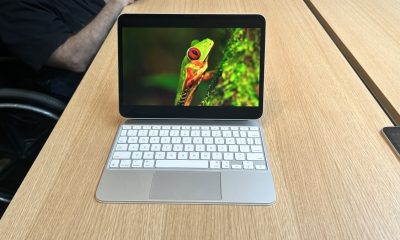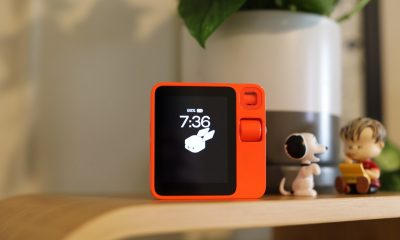Technology
A prototype disguised as a finished product

If I took a shot for the amount of times I’ve wanted to throw the OnePlus Watch out the window while testing it, I’d be very drunk. I say this because my experience with this thing has been anything but pleasant.
As OnePlus’ first-ever smartwatch, I figured there would be some aspects of it that would need improvement — maybe its fitness tracking would be slightly off, or the battery life would be mediocre, or the watch bands would be uncomfortable. After all, not every product is perfect at launch, especially first attempts. So I didn’t go into this thinking the OnePlus Watch would be a home run.
Long battery life • Fast charging • IP68 certified
Only offered in one size • Too large for small wrists • Doesn’t come with different size bands • Display is tough to see in direct sunlight • Limited customization on watch and app • Buggy sleep tracking • No third-party apps • No always-on display • Currently only compatible with Android
The OnePlus Watch might pack all the right competitive features and sensors at a reasonable price, but it struggles to properly function as a useful smartwatch.
Still, I was excited for it, considering it packed all of the same features as pricier smartwatches for a reasonable $159. The OnePlus Watch comes equipped with an SPO2 sensor to measure blood oxygen, built-in GPS to track distance, a heart-rate monitor, sleep and stress tracking, and up to a week’s worth of battery life. All of that is impressive for under $200.
Even when I found out that it was only offered in one 46mm size (which is way too big for my wrists), I was still willing to give it a chance. But the combination of its buggy sleep tracking, unpredictable heart-rate measurements, as well as super dated mobile app and operating system made reviewing the OnePlus Watch more of a hazard than help to my health and wellness.
Don’t even get me started on having to go out of my way to buy a new watchband (on a Saturday, nonetheless).
If the wrist fits …
A smartwatch shouldn’t be worn on your forearm. But since the OnePlus Watch only comes in one 46mm size, I had no other choice. I already ranted about this in my first-impressions piece, but in short: It’s way too big for small wrists like mine.
It’s actually shocking to me that OnePlus thought it could get away with only releasing one band size. I’d be less critical if the Watch came with an additional band — the same way Apple Watch and Fitbit Versa include an extra size option (with more notches on it) out of the box.
Look at all that room on my wrist!! THAT’S TOO MUCH ROOM.

Image: zlata ivleva / mashable
Alas, I had no choice but to wear the OnePlus Watch using the band’s tenth and last notch, and it was still too loose on me. If this were a traditional watch, I wouldn’t complain because I’m not one to turn down an oversized watch for the sake of fashion.
But it becomes a problem when sensors are involved. Seeing as how the OnePlus Watch packs a heart-rate monitor and an SPO2 sensor underneath the watch face, this loose fit can result in inaccurate readings. And that’s exactly what I experienced throughout my time with it.
Thankfully, it is compatible with third-party watch bands. So as a last resort, I had to hunt down a smaller band and managed to find a compatible $8 one that was originally meant for the 46mm Samsung Galaxy Watch 3. Out of the 15 notches on it, I was able to finally secure a snug fit using the second to last one.
It’s nice to know that it’s possible for such a large watch case to fit a tiny wrist, but I shouldn’t have had to go out of my way to make it work. And while $159 doesn’t exactly break the bank, it’s not worth spending any more money for the OnePlus Watch on top of that.
Your other “official” option is to contact OnePlus customer service and request a smaller band. But if you don’t want to wait for it to arrive, you can go out and buy a third-party option like I did. Or, you can return the watch altogether (I won’t judge).
Going above and beyond like this would be worth it if the OnePlus Watch were at least aesthetically pleasing to wear and functioned properly … but it fails on both accounts.
Not much to look at
The OnePlus Watch’s unremarkable stainless steel case houses a 1.39-inch AMOLED display with 454×454 pixel resolution. It’s dust- and water-resistant (up to 50 meters), with fairly thin bezels and a screen that looks crisp … from afar. However, the closer your eyes get to the display, the more pixelated the font and iconography appear.
To accommodate the screen’s readability in a variety of environments, you can manually select the brightness setting, or set it to auto. But it doesn’t get very bright when in direct sunlight. There were times when I struggled a bit to see my metrics while going for a run outdoors. And no, there isn’t an always-on display option, which is a bummer.

Navigating the screen is easy: Swipe down for shortcuts (i.e., Do Not Disturb, Brightness, Settings, Alarm, Find My Phone, and Flashlight), swipe up for notifications, and swipe to the left for music playback controls, heart rate, and sleep metrics.
On the right side of the Watch are two buttons, one of which has OnePlus’ brand stamped to it. The top button (the branded button) acts as the main dial, so it brings you to the app list and also back to the main screen. The bottom button is the function key which you can use to trigger any app function including tracking for heart rate, stress, and sleep, as well as workout modes, music, and more.
The Watch also has a speaker on the left and a microphone on the right, so you can take calls on it. But since OnePlus doesn’t offer an LTE version, you’ll only be able to take and accept or reject calls via Bluetooth when your phone is nearby.
Ah, in case you forget this is a OnePlus Watch, the branding is right there for you.

Image: zlata ivleva / mashable
It also comes in three colors: midnight black, moonlight silver, and cobalt (limited edition). North America only gets the midnight black and cobalt versions, the latter of which is made of corrosion-resistant stainless steel and sapphire glass, and will likely be more expensive.
OnePlus sent me the midnight black color and, suffice to say, I was less than thrilled. The Watch looks boring and bland like this, especially coming from a company like OnePlus.
I mean, this is a brand that doesn’t shy away from innovation when it comes to design. Its AirPods knockoffs aside, OnePlus smartphones have always been really cool. The OnePlus 6T was one of the first phones in the U.S. to feature an in-display fingerprint sensor, while the OnePlus 7 Pro featured a pop-up selfie camera. There’s also its concept phones: The OnePlus Concept One has disappearing rear cameras and the OnePlus 8T Concept phone changes color.
You’ll definitely want to swap out those watch bands if you have smaller wrists.

Image: zlata ivelva / mashable
Look, I’m not sure what OnePlus could’ve done differently because I’m not a design lead. Maybe brighter color options like the Nord? A square-shaped case? More sizes? Any type of experimentation would’ve been appreciated.
Instead, it looks one of those budget smartwatches you’d find strolling through the show floor at a trade show like Mobile World Congress or the Consumer Electronics Show.
An extremely bare-bones OS and connected app
I try not to read the comments on my YouTube videos, but once in a blue moon they can be eye-opening like this one from my OnePlus hands-on.
I agree, Ameer. I agree.

Image: screenshot / youtube
Prior to this review, OnePlus had forbid press from showing the Watch OS in action and now I know why. It’s a frustrating and buggy experience. It’s also proof the company rushed out what is clearly unfinished software.
Rather than opt for Google’s WearOS platform for its Watch, OnePlus went with its own proprietary operating system and connected app. It was an understandable choice, considering WearOS is known for draining battery life. But after having used the company’s homegrown OS, that approach now seems ill-advised.
Setting up the Watch was the easiest part of the whole experience. It connects to the Android-only OnePlus Health app, which is separated into three parts:
-
Health (where all your daily metrics live)
-
Fitness (where all you can do is track your runs and walks)
-
Manage (where you can change watch faces, and alter device settings)
The Health tab is likely the only section you’ll really use. When you tap on a specific tile, such as heart rate, SPO2, or stress tracking, it gives you a more intricate breakdown of your results based on the day, the week, and the month.
Other than that, there’s really not much to it. While it’s easy to use, it’s not at all customizable. You can’t move the tiles around for a better viewing experience, or choose which ones you want to see and which you want to hide. The most you can really do is set step and calorie-burning goals. The interface looks like something you’d see back in 2014 during the initial rise of smartwatches.
For anything more extensive, you can sync your metrics to the Google Fit app. That alone should tell you all you need to know about the OnePlus Health app.
See? It’s ugly.

Image: screenshot / oneplus
When you tap on a specific tile, you can see more information.

Image: screenshot / oneplus
OnePlus’ Watch OS feels just as dated as its connected Health app. There’s only one watch face that allows you to customize the widgets you want to see on the screen, and you also can’t download any third-party apps. So if you use apps like Strava, MapMyRun, MyFitnessPal, and even Google Fit, then you’ll have to take your phone along with you.
For music, the Watch has 4GB of standalone storage so you can store up to 500 songs on it. But that requires manually uploading music to the Watch, which is something I would never take the time out of my day to do. It’d be a lot more ideal if users could just download music apps like Spotify and Pandora.
Overall, the OnePlus Health app and OnePlus Watch OS just don’t feel well thought out. Either the company rushed out its operating system to meet a launch target or it didn’t really take the user experience into account all that much when designing it.
Fitness tracking … in theory
Under the hood, the OnePlus Watch packs a heart-rate monitor, SPO2 sensor (to track blood oxygen levels), an accelerometer, barometer, gyroscope, and built-in GPS. The Watch is also supposed to offer 110+ workout modes, but at the moment there are only 14 available:
-
running
-
fat burn run
-
outdoor cycling
-
indoor cycling
-
outdoor walk
-
swimming
-
elliptical trainer
-
rowing machine
-
badminton
-
mountaineering
-
cross-country
-
cricket
-
yoga
-
freestyle training
In addition to tracking basic metrics like duration, distance, calories burned, and average pace throughout my runs, the Watch also tracks heart-rate zones (i.e., warmup, fat burning, endurance, anaerobic, and threshold), cadence, and elevation throughout my runs. I do appreciate these more in-depth metrics, however, I’m not quite sure how accurate they are.
For some reason, OnePlus held off on including all of its workout modes.

Image: zlata ivleva / mashable
To test heart-rate accuracy, I wore both the OnePlus Watch and Apple Watch SE to compare average heart rate and distance on two one-mile runs and a one-mile walk.
During my first one-mile run, the OnePlus Watch’s reading was off from the Apple Watch by 12 beats per minute (BPM). At first, I thought it was because I was wearing the original (and too large) watch band. But switching to a tighter band on my second run didn’t help, either — the Apple Watch tracked my run at 177 BPM whereas the OnePlus Watch logged 140 BPM. That’s a difference of 37 BPM.
The metrics weren’t off throughout the entire run, though. At some points during my second run, the OnePlus Watch did catch up to the Apple Watch. But the sensor had a tendency to lag whenever my heart rate would slow down or increase, whereas the Apple Watch kept up. It seems like the OnePlus Watch performs a lot better with less intense activity. During my one-mile walk, there was only a difference of one BPM between the smartwatches.
Fitness buffs should probably look elsewhere.

Image: zlata iveleva / mashable
It’s worth pointing out that the OnePlus Watch was at least accurate when tracking my resting heart rate throughout day. Normally, I’m at about 74 BPM per day and the OnePlus Watch calculated that at 72 BPM.
Distance tracking also proved to be unreliable. Throughout both one-mile runs, the OnePlus Watch tracked 0.8 miles to the Apple Watch’s one mile (props for consistency, I guess). It did a lot better during the one-mile walk, tracking 0.91 miles when the Apple Watch hit one mile. Clearly, this thing isn’t built for tracking extreme workouts.
In mid-May, OnePlus said it plans to issue an over-the-air (OTA) update that will include GPS optimization and the full catalogue of workout modes. So we’ll have to check back and see if distance tracking improves then.
It’s not all bad, though … at least the SPO2 sensor works. Whenever I tested it up against the Apple Watch, it was only off by about one percent. It works in the background throughout the day and night but you can also check it manually. Measuring it is super easy too — all you have to do is open the Blood Oxygen app on the smartwatch and sit still during the measurement.
At least the SPO2 sensors were accurate.

Image: zlata ivleva / mashable
The OnePlus Health app then syncs the measurement and gives you more information on exactly what it means. Depending on your SPO2 percentage, it tells you whether you’re at risk for hypoxemia (i.e., when there’s a low level of oxygen in the blood). Since it doesn’t have FDA clearance, however, you should consult your doctor about any results you find abnormal.
What’s puzzling is that you can’t set alerts for low measurements. According to the app, there were six days out of the week when I had low SPO2 and I never received a notification about it. Personally, that’s something I would’ve liked to be aware of in real-time instead of finding out days later.
Apparently, I’ll sleep when I’m dead
According to the OnePlus Watch, I consistently get two hours and 52 minutes of sleep per night. One night, in particular, I apparently only had 59 minutes of sleep. And yet, somehow, I was still able to wake up the next morning and make it through an eight-hour work day without crashing!
If you couldn’t already tell, this Watch is awful at tracking my sleep. OnePlus said that it’s likely because the watch band is too loose on my wrist and the sensors weren’t picking up on my metrics (which is something I’d already figured out in my hands-on).
News flash: It’s not the watch band, OnePlus. It’s the smartwatch.
Remember that smaller, third-party watch band I mentioned earlier? Well, it fits me perfectly fine and yet I’m still waking up to ridiculously paltry sleep metrics.
Ah yes, two hours and eight minutes of sleep. I feel so well-rested.

Image: zlata ivelva / mashable
Let’s take my Sunday night sleep for example: The OnePlus Watch says I slept from 8:01 p.m. to 10:50 p.m., while the Google Nest Hub (which I’ve also been using to track sleep) says I fell asleep at 1:14 a.m. and woke up at 8:37 a.m.
I’ll let you decide which one is more accurate.
I’ve personally given up on trying to make the OnePlus Watch work for sleep tracking. But those who don’t have this problem (and I’d like to know who you are!) will actually be able to take advantage of all the features that come with sleep tracking.
Similar to Fitbit’s smartwatches, the OnePlus Watch tracks your sleep stages throughout the night (i.e., light and deep stages), duration of your sleep, time spent awake, time you go to bed, and time you wake up. It then takes those numbers and provides you with a sleep assessment, which basically scores your sleep quality.
As for my sleep assessment, well, the OnePlus Watch has deemed my sleep quality as “poor.” Apparently, I suffer from sleep deprivation and insufficient deep sleep. I’ll be sure to add “get more than two hours of sleep” to my to-do list.
OnePlus said that another OTA update for sleep tracking will be available later this month, but it doesn’t address the inaccurate stats. Instead, it’s supposed to fix sleep recordings that aren’t syncing to the OnePlus app, which I never had a problem with.
At least the battery life is good?
The only thing worth praising on the OnePlus Watch is its battery life — sorta. With a 402mAh battery, OnePlus claims you can get up to one week if you use it everyday, and up to two weeks if you wear it infrequently.
At the time of writing, it’s currently at 61 percent and was last charged six days ago. That’s after wearing it all day to track my metrics, exercising with it twice (about 30 minutes each workout), and wearing it throughout the night to track my sleep.
Normally, I would say that’s impressive but I’d take that battery percentage with a grain of salt. Since the Watch was way too big on me, I’d often take breaks wearing it. And because of its size, I’m convinced the sensors weren’t always working to the fullest recording my metrics.
The only good thing it has going for it is battery life and fast charging.

Image: zlata ivleva / mashable
Regardless, that’s more mileage than I’d get with the Apple Watch Series 6 (which lasts me until the next morning, at most) or any WearOS smartwatch that barely reaches the 12-hour mark.
And unlike those other smartwatches which take a while to charge, the charging puck that comes with the OnePlus Watch has the company’s super-fast Warp Charge technology. It provides a fully day’s worth of juice with a five-minute charge, and up to one week with a 20-minute charge. However, you’ll have to find your own USB-A power adapter since OnePlus doesn’t give you one.
Thinking about alternatives? Good, because you should be.
If you’ve made it this far into the review and you’re wary about purchasing the OnePlus Watch, then I applaud you for having good intuition. There are alternatives out there that are actually worth your money:
-
Fitbit Versa 3: For $229.95, the Versa 3 packs all the same sensors as the OnePlus Watch. And while it is more expensive, you can rest assured that it’s fully functional and a lot more accurate as far as fitness tracking goes.
-
Samsung Galaxy Watch 3: Starting at $159.99, the Galaxy Watch 3 also packs the same sensors (plus the addition of an ECG sensor with FDA clearance) and comes in two sizes: 41mm or 45mm. So those of you with smaller wrists won’t have to find a way to make the smartwatch work.
-
Apple Watch Series 6: If you have an iPhone, then you’re better off with this one. It’s almost double the price of the OnePlus Watch, but as with the above smartwatches, you get all the same sensors including an SPO2 monitor. And, having reviewed it, I know that it’s super accurate in terms of fitness tracking.
What the heck happened, OnePlus?
I can assure you, my stress was anything but normal while reviewing this watch.

Image: zlata ivleva / mashable
On paper, the OnePlus Watch truly sounds promising. In practice, it’s anything but.
I’m curious to know if anyone on the OnePlus team actually quality checked these review devices before sending them out. The entire experience just felt incredibly unpredictable and made it tough to really trust any of the recorded metrics. Until the company actually fixes these issues, it’s going to be tough to recommend the Watch to, well, anyone.
OnePlus did just push out a software update ahead of this review, but the only change is that there are now 50 more watch faces. And… there’s not much I can do with that.
Whether or not OnePlus plans to actually fix all of the Watch’s actual pain points remains to be seen. So while I wait for those significant OTA updates to come, this thing will be sitting not so pretty in my desk drawer collecting dust.
Look, I’m all for giving second chances, so perhaps the inevitable second-generation OnePlus Watch will be a lot better.
That is, if there even is one.
-

 Business7 days ago
Business7 days agoGoogle lays off workers, Tesla cans its Supercharger team and UnitedHealthcare reveals security lapses
-

 Entertainment4 days ago
Entertainment4 days agoiPad Pro 2024 now has OLED: 5 reasons this is a big deal
-

 Business6 days ago
Business6 days agoThe Rabbit r1 shipped half-baked, but that’s kind of the point
-

 Entertainment5 days ago
Entertainment5 days agoWhy should we care what celebrities like Taylor Swift and Billie Eilish say about Palestine?
-

 Entertainment4 days ago
Entertainment4 days ago‘Stardew Valley’ has an official cookbook. Here’s how to make Seafoam Pudding.
-

 Business4 days ago
Business4 days agoLegion’s founder aims to close the gap between what employers and workers need
-

 Business4 days ago
Business4 days agoNBA champion Kyle Kuzma looks to bring his team mentality to Scrum Ventures
-

 Business3 days ago
Business3 days agoCheckfirst raises $1.5M pre-seed, applying AI to remote inspections and audits






















